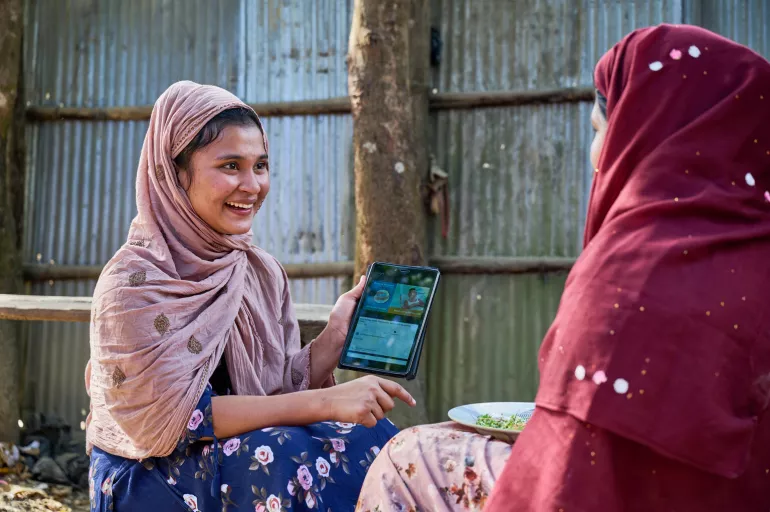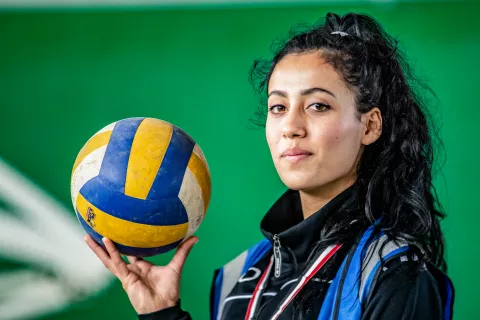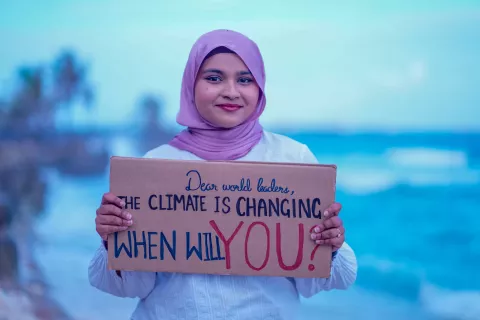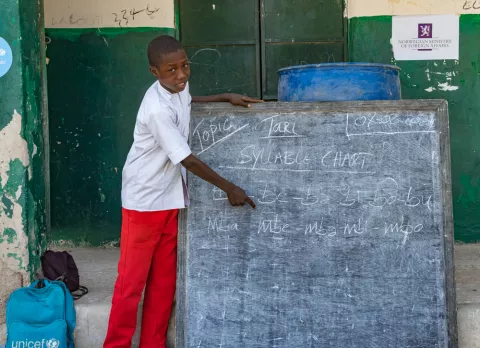Did you know that the power of computers has been doubling roughly every two years since the 1960s? Every day it seems there’s a new app or piece of tech that unlocks new and efficient ways to do things; to better engage with the world, or with learning.
However, the COVID-19 pandemic exposed the longstanding gender digital divide. Even though digital tech can be used to continue education at scale and is rapidly becoming core to the educational enterprise, it only benefits those who can access it.
And millions of girls often don’t have access to digital technology for many reasons: because communities, schools or families think that technology is a male-only domain, because of online safety risks, because they have been uprooted from their homes or forced to leave school before they learn to use computers, or because they never go to school in the first place. Even when girls can access digital learning, the content may be rife with harmful gender norms – just as it often is in textbooks. Stereotypes are perpetuated and girls’ education suffers.
Providing access to the tech hardware can make an enormous difference, but it is not a silver bullet. Digital learning isn’t just putting existing materials on a screen instead of on a chalkboard or in a textbook. It is about taking the opportunity to make education systems better and more responsive to the gender-specific needs of children and young people and equipping teachers with the skills to do so. It can only do that if we’re intentional about how we want to use it.
Recently, the Transforming Education Summit (TES) has committed to doing just that: to “harness the power of the digital revolution to ensure quality education is provided as a public good and a human right, with a particular focus on the most marginalized.” Unlocking the power of digital learning for these children and young people, especially girls, relies on three keys:
- Connecting children to digital learning irrespective of their gender identity, where they live or where they come from UNICEF is working to connect every school to the Internet by 2030 through the Giga initiative.
- Developing and adapting high quality learning content so that it’s context-specific, curriculum-aligned, and accessible to all. UNICEF with UNESCO and partners launched Gateways to Public Digital Learning, a new global initiative to ensure that every learner, teacher, and family – especially the most marginalized – can easily access and use high-quality digital education content. To facilitate access to high quality content, UNICEF’s Learning Passport is helping meet the specific needs of learners- especially those forced to leave their homes - and educators in over 28 countries reaching three million children.
- Equipping teachers with the capacity to use digital technology to improve learning as well as with gender-responsive pedagogical skills so they can support children in all their diversity to develop the skills they need for school, life, and work – including supporting girls and young women to develop digital literacy.
One way UNICEF is forging this third key is through the new Gender Responsive Digital Pedagogies guide for educators. The Guide uses practical exercises to help teachers produce gender-responsive lesson plans, learning materials, and instruction, as well as guidance on protecting girls and boys from online bullying, violence, and sexual violence – critical skills in the digital age. It also outlines strategies to engage parents and caregivers in their child’s learning using digital tools. In Lebanon, UNICEF has worked closely with the Center for Educational Research and Development (CERD) – a national organization charged with modernization and development of education, based on educational planning – to integrate part of the guide into their teachers’ training curricula.
This national uptake reflects our commitment: We want to ensure that, as the world accelerates the use of digital technologies for education, we don’t simply carry over existing biases and harmful gender norms into teaching and learning. With digital tech, learning tools can easily be replaced or updated – unlike printed materials. Educators can thus hone materials to be context-specific and, critically, remove harmful gender references and stereotypes from curricula. How teachers interact with girls and boys can model more equal and gender-transformative expectations of themselves and each other.
Digital learning has the advantage of being mobile, opening doors for alternative learning pathways for children and adolescents who are excluded or need flexible arrangements. It can make quality learning accessible to children who speak minority languages and children and young people on the move – especially important for girls on the move, some of the most vulnerable people in the world. In situations that are otherwise hostile and uncertain, digital learning can be a way to help children to feel included and prepare them to succeed in school, work, and life.
Ensuring that girls’ access to digital technology is keeping pace with its proliferation and technological changes is and will not be easy. But it is essential. The new Guide is a global public good – a critical building block for action on the TES commitments. Furthermore, as the 67th Conference on the Status of Women focuses on how innovation and education in the digital can promote gender equality, policymakers can be catalyst for digital learning. To keep pace, our learning tools, practices, and policies need to stay up to date to match the technology – and champion the rights of all children, in all their diversity.
Robert Jenkins is the Global Director of Education and Adolescent Development at UNICEF.
Lauren Rumble is the Associate Director of Gender Equality at UNICEF.
Verena Knaus is the Global Chief of Migration and Displacement at UNICEF.





